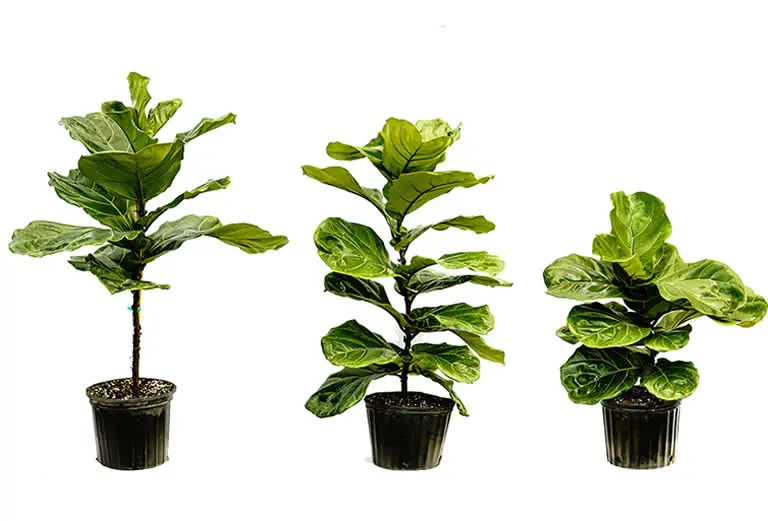The Fiddle Leaf Fig (Ficus lyrata) is one of the most dramatic and recognizable houseplants around. With its oversized, violin-shaped leaves and tall, tree-like form, it has a way of commanding attention in any room. While it has a bit of a diva reputation, caring for a Fiddle Leaf Fig doesn’t have to be difficult if you understand its preferences and stay consistent.
Here’s how to care for this striking plant indoors and out, how to avoid the most common issues, and what it needs to thrive in your home.
Table of Contents
- Bright Light with a Soft Touch: Finding the Ideal Spot Indoors
- Let It Breathe Between Waterings: How to Water a Fiddle Leaf Fig
- Warm, Stable Airflow: The Climate Your Fiddle Leaf Fig Craves
- Feeding for Height and Health: Fertilizer Tips That Work
- Repotting with Care: How to Support Growth Without Shock
- Pruning Fiddle Leaf Figs: Shaping, Strengthening, and Controlling Size
- Best Place in the Home: Where Fiddle Leaf Figs Really Thrive
- Caring for Fiddle Leaf Figs Outdoors: A Seasonal Boost in Warm Weather
- Common Fiddle Leaf Fig Problems and How to Fix Them
- Final Thoughts
Bright Light with a Soft Touch: Finding the Ideal Spot Indoors
Fiddle Leaf Figs need bright, indirect light to thrive.
A few feet from a large, sunny window is ideal.
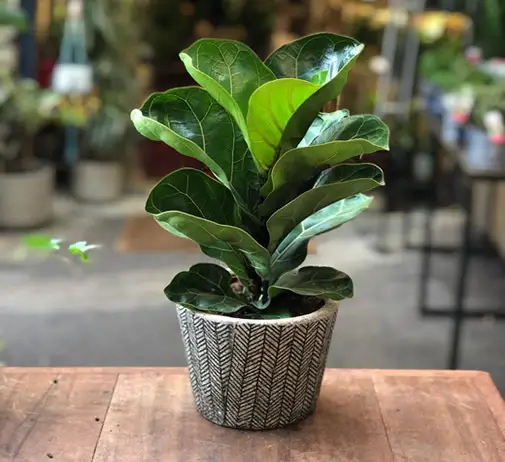
Morning sun is usually fine, but avoid harsh afternoon rays, which can scorch the leaves.
Low light or inconsistent lighting will lead to leaf drop, legginess, or slow growth.
Rotate the plant every couple of weeks so all sides get equal light and it grows evenly.
Let It Breathe Between Waterings: How to Water a Fiddle Leaf Fig
These plants prefer to dry out slightly between waterings.
Water thoroughly when the top two inches of soil are dry, allowing the water to drain freely.
Never let the plant sit in standing water.
Overwatering is one of the most common issues and often results in brown spots or root rot.
During winter, reduce watering frequency as the plant’s growth slows down.
Warm, Stable Airflow: The Climate Your Fiddle Leaf Fig Craves
Keep your Fiddle Leaf Fig in temperatures between 65°F and 80°F and away from cold drafts, heaters, or sudden temperature changes.
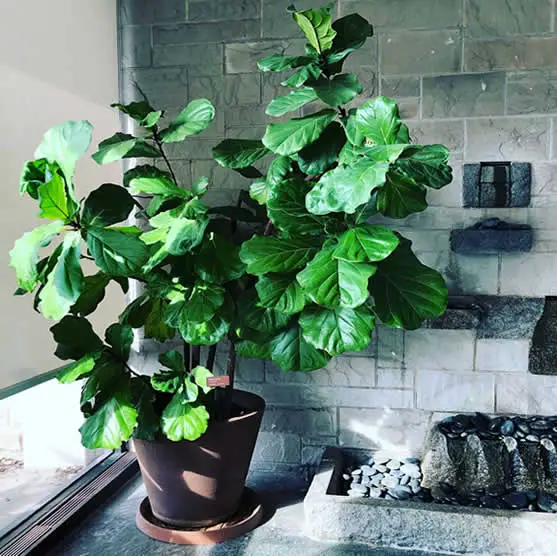
It prefers a stable environment with moderate humidity.
If the air is very dry, especially during winter, consider misting the leaves or placing a humidifier nearby to prevent leaf edge browning.
Feeding for Height and Health: Fertilizer Tips That Work
During the growing season, feed once a month with a balanced liquid fertilizer diluted to half strength.
You can also use a slow-release fertilizer in spring for long-term feeding. This little care kit is ideal for Fiddle Leaf Fig as it contains everything you need to take care of your plant and comes with an ideal fertilizer.
Don’t fertilize during fall and winter, when the plant naturally slows down.
Regular feeding supports healthy leaf production and encourages upward growth.
Repotting with Care: How to Support Growth Without Shock
Repot your Fiddle Leaf Fig every one to two years or when roots start circling the pot.
Choose a pot one size up with good drainage and use a high-quality, well-draining indoor plant mix.
Spring is the best time to repot.
Be gentle with the root system and keep the plant in the same lighting conditions after repotting to minimize stress.
Pruning Fiddle Leaf Figs: Shaping, Strengthening, and Controlling Size
Pruning is one of the best ways to control the height, shape, and health of your Fiddle Leaf Fig.
Trim the top of a leggy plant to encourage branching, or remove lower leaves and stems to create a tree-like appearance.
Always prune in spring or early summer when the plant is actively growing.
Use sharp, sterile shears and make your cuts just above a node or leaf.
If you’re looking to thicken the trunk, pruning the top can help redirect energy to the base.
Remove any damaged, yellowing, or inward-facing leaves regularly to keep airflow moving through the canopy and maintain the plant’s overall structure.
Best Place in the Home: Where Fiddle Leaf Figs Really Thrive
Fiddle Leaf Figs are best placed in living rooms, sunny bedrooms, or bright home offices with plenty of indirect light.
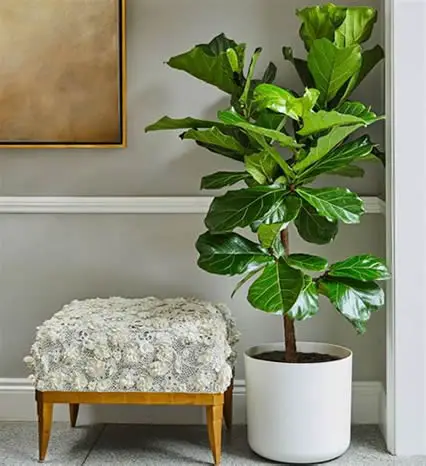
They need space to grow vertically, so give them room to stretch, and avoid squeezing them into low or shadowy corners.
They look especially beautiful as statement plants next to windows or beside furniture.
Caring for Fiddle Leaf Figs Outdoors: A Seasonal Boost in Warm Weather
In USDA zones 10–12, Fiddle Leaf Figs can grow outdoors year-round as ornamental trees.
In cooler climates, they can be moved outside in late spring once temperatures stay above 60°F at night.
Place them in a sheltered spot with bright, indirect light—never in direct afternoon sun, which can scorch the leaves.
Outdoors, they’ll appreciate the fresh air and extra light, which often triggers a burst of new growth.
Water more frequently, as soil will dry faster outside.
Before bringing the plant back indoors in fall, inspect it carefully for pests and rinse the leaves to remove dust or debris.
Common Fiddle Leaf Fig Problems and How to Fix Them
Brown spots or edges on leaves are usually a sign of overwatering, underwatering, or low humidity
Fix it by checking soil moisture and drainage, watering consistently, and increasing humidity if needed
Leaf drop can happen from sudden changes in light, temperature, or overwatering
Fix it by placing the plant in a stable spot with bright indirect light and avoiding drastic changes
Yellowing leaves often point to overwatering or poor drainage
Fix it by letting the soil dry more between waterings and making sure the pot isn’t holding excess water
Dusty, dull leaves may block light and slow photosynthesis
Fix it by gently wiping leaves with a soft, damp cloth every couple of weeks
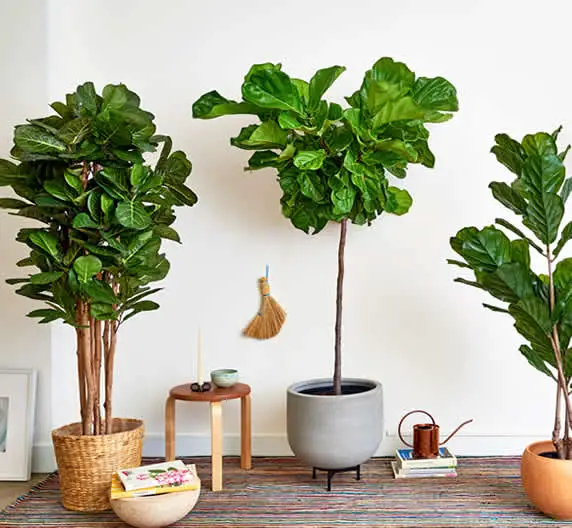
Stunted growth or no new leaves could mean the plant needs more light or nutrients
Fix it by moving to a brighter location and resuming regular feeding during spring and summer
Curling leaves are often a response to underwatering or temperature stress
Fix it by checking the soil moisture and keeping the plant away from drafts or heating vents
Final Thoughts
The Fiddle Leaf Fig might have a dramatic side, but with the right balance of light, water, and attention, it will reward you with towering growth and bold, glossy foliage.
It’s not the kind of plant you forget about, and that’s part of its appeal.
Treat it with consistency, learn its rhythm, and you’ll have a striking, sculptural companion that truly elevates your space.
Be sure to read our article Fiddle Leaf Fig Propagation: How to Grow New Plants From Your Existing Tree for detailed steps on propagating these evergreen plant easily.

